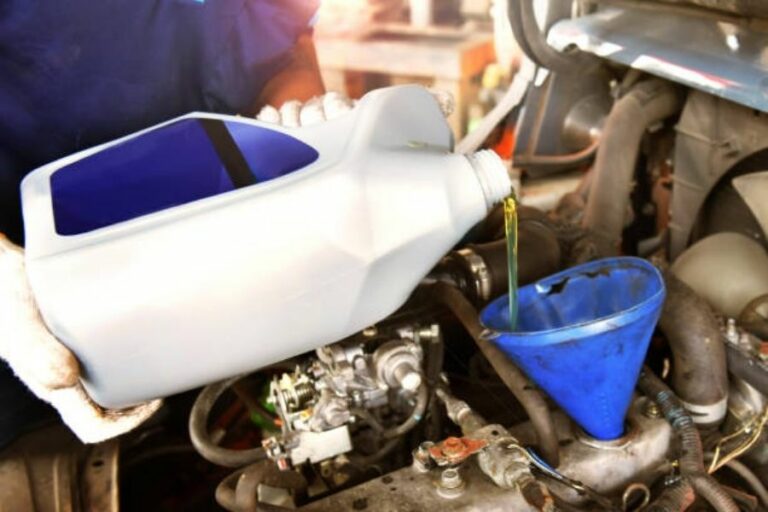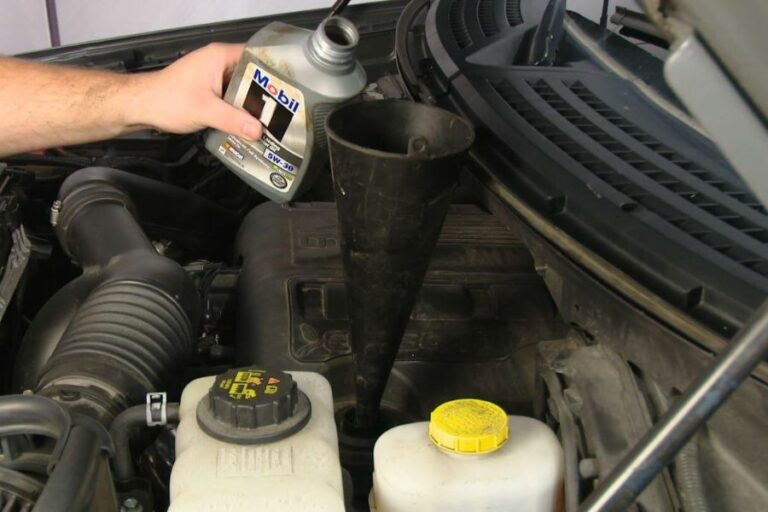Toyota Tacoma Transmission Fluid Change Guide: Step-by-Step
Toyota Tacoma transmission fluid change is a bit tricky because the pump doesn’t really tend to fit the liquid bottle. So, the oil overflows, and the pan is half empty.
To avoid all these inconveniences, you must be familiar with the chaning transmission fluid guide of Tacoma.
Adding oil on manual transmission only requires pulling plugs and pumping liquid. The automatic gearbox includes much more than that, which we’ll discuss here!
How Often Should You Change Transmission Fluid in a Toyota Tacoma?
The Tacoma transmission fluid change interval depends on how old, or new the it is. If you have bought it recently, you can exceed 100000 miles without changing the fluid.
For older vehicles, stick closely to the manufacturer’s guide. They’d recommend draining and filling oil every 30000 to 60000 miles. Otherwise, the vehicle compartments start wearing out.
What Is the Ideal Type of Transmission Fluid for a Toyota Tacoma?
Just because Tacoma configures manual or automatic gearboxes doesn’t mean that they’ll only take traditional fluids.
Sometimes, you can use multi-vehicle types to perform in high or low temperatures or heavy duty. But for which engine type? Follow the chart:
| Engine | Transmission Type | Fluid |
| 4 L | A340E automatic transmission | Multivehicle transmission |
| 4 L | A750F automatic transmission | Multi Vehicle fluid |
| 2.4 L | W59 5-speed manual transmission | Manual and automatic transmission |
| 3.4 LV6 | 4 speed A340F automatic transmission | Traditional ATF |
Read Also: Jaguar S Type Transmission Fluid Capacity & Recommendations
How to Check Transmission Fluid on a Tacoma?
Some Tacoma pickup trucks have dipstick handles, and others do not. In that case, you need to check the fluid through the dipstick or valve as described below:
Step 1: Prepare
First off, park the vehicle on even ground, and keep the engine at normal operating temperature. Wear safety glasses and gloves to save yourself from the toxic chemicals of the fluid.
Step 2: Raise the Hood
Pull the hood release lever located at the cabin and push it to pop the hood up. Then, lift the hood by releasing the safety catch at the middle front of the vehicle. Attach the hood pop to the hood to keep it lifted securely.
Step 3: Read the Dipstick
Go through the manual instructions to find the dipstick handle and pull it out. Afterward, clean it with a dry cloth or paper towel away from inflammable objects. Replace the handle and pull it out again. If the fluid is below the Fill line, it is time to add oil.
Now, let’s rub some fluid on your gloves to see and smell its color. Pinkish fluid indicates you don’t need to drain the liquid. But if there is any debris or burnt smell in the red fluid, change the transmission oil immediately!
Step 4: Check the Valve
If your car has no dipstick, lift the vehicle with a hydraulic lifting tool and check the valve at the bottom of the gearbox. And if you find any leakage, book a fluid-changing schedule with an automobile service center.
Read Also: Duramax Allison Transmission Fluid Change Interval
How to Add/Change Tacoma Transmission Fluid Change?
As the Tacoma trucks have two types of transmission pans and different engine models, the transmission fluid changing guide slightly varies as per other specs. So, follow these steps according to the model of your vehicle:
Method-1: For Manual Transmission
It is much easier to change the fluid on the manual gearbox as you don’t need to handle the connectors here, unlike the automatic transmission. Just be careful enough with the sequence of removing the plugs as described.
Step 1: Loosen the Plugs and Drain Fluid
With a wrench or socket extension (for 4wd), loosen the fill plug enough so liquid can enter it.
Then, loosen the drain plug and remove both drain and fill plugs simultaneously. Remember to place a tub under the plug before draining the liquid.
Step 2: Clean Plugs
Using a dry clean cloth, wipe off any debris or dirt around the transmission and drain plug magnets. Avoid cleaning near flammable objects. Also, reinstall an anti-rust drain plug if there is rust buildup on the plug.
Step 3: Change the Fluid
Now; with the help of a thin funnel, add the fluid as per the manufacturer’s recommendation. Or insert a pump into the transmission oil bottle and pump the oil to the transmission. And replace the plugs securely to ensure no leakage or overflow.
Method-2: For Automatic Transmission
Before jumping to change the fluid on the automatic transmission, go through the manual and understand the OBD connectors first. Then, follow these steps utilized for automatic transmission.
Step 1: Remove the Plugs
Here, loosen and take off the fill plug located at the passenger side of the transmission. Don’t drain the oil before detaching the fill unit, otherwise, you will need to spend bucks in tow servicing.
Then, locate the overflow plug at the bottom of the gearbox and loosen it with a wrench but do not remove it. After placing a can under the transmission pan to catch the fluid, pull out the drain plug. Now, measure the drained oil correctly.
Step 2: Add the Fluid
Reattach the drain and overflow plugs. With a funnel or hose, pump the fluid to the transmission and ensure the filled fluid is ⅓ quartz more than the drained liquid.
After you slightly overfill the pan, attach the fill plug. Put the engine in idle motion and change the shift through all gear positions.
This will allow the fluid to flow smoothly and lubricate the pan to increase its friction durability. Now, feel free to set the shift to park option.
Step 3: Jump Pins or Connectors
The correct fluid temperature is necessary to verify the liquid is at the required level. So, to check the temperature, you’ll need to jump two pins on the white connector. The board or OBD with pins is at the driver’s kick panel. Use a wire to jump the pins.
The connectors start from the top left corner with pin #1 and end at the bottom right corner at #16.
To determine which pin is what number, count from the top left as you read a book and jump #4 and #13 with a wire. This way, it’ll start the engine, and some dash indicators will flash.
Step 4: Shift Gears
Let’s change the gear from P to N and wait for a few seconds at N. Then, make six shifts from N to D to N to illuminate the AT TEMP light for 2 seconds.
Return to the P position, idle the engine, and notice whether the TEMP indicator lights up. The illuminating light signals the truck has entered TEMP Check Mode.
AT Temp light illuminates continuously to confirm that the fluid temperature is ideal for checking the changed fluid level.
So, detach the overflow plug, and a small amount of oil will flow out and indicate that you have poured the required amount.
However, no flow signals that you need to add more liquid. If the indicator flashes, shut off the engine and let the oil cool. Then, check the ATF level after 2 hours.
You can watch the tutorial for better clarity:
Read Also: Nissan Murano Transmission Fluid Change Interval
Symptoms of Dirty/Low Transmission Fluid on Toyota Tacoma
Unlike motor oil, transmission fluid needs frequent maintenance. Or else the vehicle starts acting up abnormally.
To protect the car, it’s important to get familiarized with the symptoms of low transmission fluid. And these are as follows:
Unusual Gear Shifts
Due to low fluid levels, while changing through gears, you’ll hear a rattle and feel a grinding force. And the car will hesitate to move even in different gears.
If there is any dirt in the gearbox, the transmission pan won’t be able to hold the liquid. And there will be a steady fluid flow, lowering the fluid level.
Heated Transmission
Without enough flow of the fluid in the pan, the transmission increases its temperature. So, upon entering the Auto Temp mode, the transmission temperature light will blink on and off. It’s a reminder that the gearbox is surpassing its required temperature to function properly.
Burning Smell
Overheated transmission burns the oil in it. So, once you start the vehicle, you can smell an overpowering burnt smell.
Not adding the fluid can make the odor even worse. The passenger seat and underneath the hood may smell like burnt or rotten eggs.
Noise
Poorly operating automatic gearbox will make whining noises while you try to take turns. And the manual one will make clunking sounds if the fluid level is too low. However, the sounds vary based on the manufacturing year and engine type.
Read Also: Nissan Cvt Transmission Fluid Change Interval
What Will Happen If You Don’t Change Tacoma Transmission Fluid?
The sealed transmission doesn’t require frequent maintenance and fluid check as its fluid has a longer lifespan. However, an unsealed gearbox does need servicing, or else it may affect the vehicle as described below –
Wear and Tear
The old fluid tends to build up debris and dirt that lead to rust buildup in the pan. When attached parts come in contact with these corroded units, they grind, especially during gear movements. And it causes wear and tear in the gearbox and other compartments.
Due to tears, the pan needs a replacement. If not, then you won’t be able to drive without sudden pause and increased acceleration that does not respond to your inputs.
Transmission Slipping
The worn-out old fluid can cause the transmission to slip. If that happens, the wheels won’t respond as per the power sent by the engine.
So, you will be unable to quickly increase the acceleration when needed. And the vehicle can’t reverse itself. Slippy transmission thus increases the risk of a car crash!
Distraction
A continuous hissing noise will come from under the hood. Because old fluid leaks and comes in contact with other exhaust manifolds.
The noise will keep increasing until you change the fluid. And it is quite a distraction while you are driving. It tends to increase your fatigue. As a result, you can’t concentrate on the roads.
Read Also: Toyota CVT Transmission Fluid Change Interval
Frequently Asked Questions
If you’re new to the specs of your Toyota Tacoma, its transmission pan is sure to confuse you regarding the fluid check and changing. To drop your doubts, have a look at these answers:
How many years does the sealed transmission fluid last in Toyota Tacoma?
The fluid on sealed transmission can work up to 5 years from the manufacturing date. The shelf life can vary as per different specs. In order to confirm, you should check the manual. Basically, it lasts up to 100000 miles.
Can you add fluid to the sealed transmission on Toyota Tacoma at home?
No, you should avoid taking up any DIY project with a sealed transmission pan. Because the manufacturers configure them in a way that the technician can handle them. You can endanger life by trying to open it.
What does the transmission fluid do on the Toyota Tacoma?
The transmission liquid prevents wear and tear by lubricating the pan and its units. It also keeps the transmission temperature ideal so that it can function properly. And most importantly, it produces power for the vehicle to move.
What is the fluid capacity of the Toyota Tacoma transmission?
It depends on the engine model and transmission type. Generally, a manual gearbox can hold from 1.8 to 2.5 liters. And an automatic pan is able to store 9.9 to 10.5 liters. You will basically find the capacity included in the manual.
Final Talk
I think now you understand about 3rd gen tacoma transmission fluid change because here I give you the complete guide about it.






